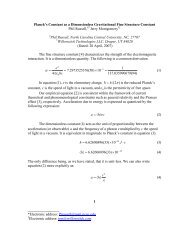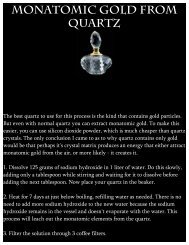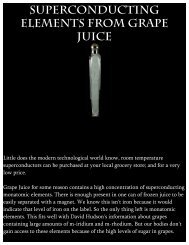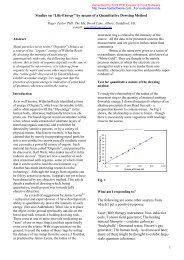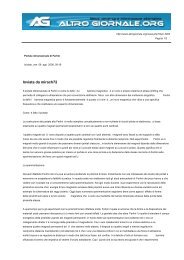Viktor Schauberger
Viktor Schauberger
Viktor Schauberger
You also want an ePaper? Increase the reach of your titles
YUMPU automatically turns print PDFs into web optimized ePapers that Google loves.
In the Repulsin B the vortex turbine has been improved for increasing the “Implosion<br />
Effect” and thus the lifting force. In the Repulsin B the upper membrane is fixed<br />
and the lower rotates at high speed. On the edge rim there are special shaped blades of<br />
boomerang configuration. There are 120 blades that are 3 degrees spaced around the rim.<br />
The enhanced vortex turbine increases significantly the “implosion” effect in the<br />
vortex chamber. This contributes to it being able to generate a stronger thrust than the<br />
centrifugal turbine used in the Repulsin A. By means of suction screw-impeller (which<br />
revolved from the outside towards the inside along a cycloid, spiral space curve)<br />
the same type of force is generated which creates twisters, cyclones, and typhoons through<br />
the effect of either suction or implosion.<br />
Work on the Repulsin B continued in 1944 at the Technical College of Engineering<br />
at Rosenhugel in Vienna. <strong>Schauberger</strong> was finally released back to Leonstein, Austria that<br />
same year. It appears that the SS had discarded the idea of applying the <strong>Schauberger</strong><br />
motor to a submarine when the benefits would greatly improve their work on the secret<br />
Flugkreisel which was taken from Rudolf Schriever back in 1941. By 1943 the machine<br />
had flown but proved to be unstable. The leader of the SS replacement team was Dr.<br />
Richard Miethe who proposed several Flugkreisel replacements with varied power plants,<br />
most of which relied on jets or rocket power, until it was learned that <strong>Schauberger</strong> had<br />
engineered a type of turbine machine that would create an up-current of axiallyspinning<br />
air so powerful that the up-current’s drag force would speed the whole<br />
machine higher and higher into the air with a thrust equal to 10,000 hp simply by<br />
moving “air”. The turbine was considered a priority for flight development into a manned<br />
machine by the SS. It is speculated that Miethe’s final design built in Breslau that flew in<br />
1944 was an enlarged manned Repulsin-type craft.<br />
<strong>Schauberger</strong> meanwhile had his remaining discoid motors confiscated by the<br />
Russians and Americans at the end of the war. While AVRO Canada approached<br />
<strong>Schauberger</strong> for disc development along with a team led by Dr. Richard Miethe,<br />
<strong>Schauberger</strong> refused and instead devoted his remaining life to peaceful uses of his vortex<br />
technology by working on various civilian projects which included generators, and both<br />
water and air purification systems. In the late 1950s <strong>Schauberger</strong> visited the US and was<br />
again pressured into working on military disc designs. The pressure was even greater<br />
due to the fact that <strong>Schauberger</strong>’s original Repulsin motors had fallen into Russian<br />
hands and the US suspected <strong>Schauberger</strong>’s technology would appear as a nuclear<br />
armed aircraft over US soil. <strong>Schauberger</strong> refused to participate again but had his<br />
designs forcibly signed over to a powerful US consortium. He returned to Austria<br />
and died there 5 months later having been robbed of everything. A tragic end of<br />
life for the man everyone named the “Water Wizard”. Compliments: Rob Arndt.



